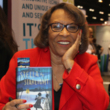Harbor me
Description
More Details
Carrera, Jose Narrator
Flanagan, Dean Narrator
Romero, Angel Narrator
Widoff-Woodson, Toshi Narrator
9780525637943
9780525515135
Excerpt
Similar Titles From NoveList
Similar Authors From NoveList
Published Reviews
Booklist Review
*Starred Review* Six fifth- and sixth-graders, all in a special class for those who learn differently, are suddenly given, by their beloved teacher, an extra hour of safe space an empty classroom where they are told they can talk about anything or nothing. At first, it's nothing. Then, Haley, the book's narrator, describes how each child begins to unfold. Esteban's story demands to be told first; Immigration Services have taken his father away. The others lend sympathy and support, and then, over the course of a school year, more confidences are shared. Ashton, one of the school's few white kids, is bullied. Amari sketches guns and worries about being shot. Puerto Rican Tiago struggles with being American, yet not American. Haley's own story is intertwined with that of her best friend, Holly. Haley's red hair comes from her father, but he's in jail and Haley's mother is dead; an uncle cares for the hyperactive Holly. The plot, at times, creaks, especially the setup. But the magic is in the writing. Woodson tells stories torn from headlines but personalizes them with poetry and memories, blunting their trauma with understanding and love. Haley's history weaves in and out, drawing readers close. These children become each other's safe harbors, and Woodson brilliantly shows readers how to find the connections we all need. HIGH-DEMAND BACKSTORY: A national author tour will support the beloved author of Brown Girl Dreaming (2014).--Ilene Cooper Copyright 2018 Booklist
Publisher's Weekly Review
Woodson (Brown Girl Dreaming) celebrates all that is essential and good for humanity-compassion, understanding, security, and freedom-in this touching novel about six children with special needs. Sixth-grader Haley and her best friend, Holly, don't know much about their four male classmates when they are placed in a self-contained classroom. They soon discover the things that they do and do not have in common when, on Friday afternoons, their teacher takes them to ARTT (a room to talk). Here, without adult supervision, the class can have conversations about anything. Usually the students use the time to unburden themselves of problems ranging from a parent's deportation to bullying in the schoolyard. Haley is the last to spill her secrets, about her mother's death and why her father is in prison, and afterwards she is rewarded with a feeling of lightness, "like so many bricks had been lifted off me," she says. Woodson's skills as poet and master storyteller shine brightly here as she economically uses language to express emotion and delve into the hearts of her characters. Showing how America's political and social issues affect children on a daily basis, this novel will leave an indelible mark on readers' minds. Ages 10-up. (Aug.) © Copyright PWxyz, LLC. All rights reserved.
School Library Journal Review
Gr 4-6-In sixth grade, Haley is part of a special class of six kids that include Holly, Esteban, Amari, Tiago, and Ashton. On the first Friday of the school year, Ms. Laverne tells them to grab their books and follow her. She leads them to what used to be the art room and gives them some simple directions. They are supposed to sit in a circle and talk. The students are confused at first. What are they supposed to talk about? Ms. Laverne assures them they can talk about whatever they want to and need to. The next Friday, Haley comes in with a recorder, telling her friends it's so that they won't forget each other. Through the "recordings," readers get to know each of the six classmates through their own words. Each character reveals the difficult things they're balancing in their lives, whether it's an incarcerated parent, a dead parent, a family split apart by immigration policies, a father who lost his job, or their daily struggles with racism and microaggressions. Woodson's spare, lyrical, and evocative prose carries the story seamlessly, weaving in themes of justice and family, friendship and courage. VERDICT This is a timely and beautifully written story that should be on library shelves everywhere.-Stacy Dillon, LREI, New York © Copyright 2018. Library Journals LLC, a wholly owned subsidiary of Media Source, Inc. No redistribution permitted.
Horn Book Review
One day, Ms. Laverne gathers her small class of fifth and sixth graders and walks them over to the old art room, where she invites them to talk to one anotherwithout her. Every Friday at two oclock, narrator Haley and her classmates sit in a circle during the last hour of the school day to talk about whatever they want. At first, the six students are skeptical and question Ms. Lavernes judgment in leaving them alonein pushing them from the Familiar to the Unfamiliarbut they soon realize the gift that she has offered them. While grappling with challenging issues of immigration, racism, incarceration, grief, and loss, they also explore deep issues of identity, community, family, change, and forgiveness. The power of remembrance is also an important theme, with Haley offering her voice recorder as a medium to collect her classmates stories and voices. As the school year unfolds, the safety and sanctity of their space deepens, as do their friendships. Woodsons (Brown Girl Dreaming, rev. 9/14) latest will speak to young peoples insecurities and fears while recognizing their courage in facing them, and her craft as a weaver of words and imagery is evident on every page. A timely tribute to the resilience of young people and to the power of human connection that often overrides our differences. monique harris (c) Copyright 2018. The Horn Book, Inc., a wholly owned subsidiary of Media Source, Inc. No redistribution permitted.
Kirkus Book Review
Just before she begins seventh grade, Haley tells the story of the previous school year, when she and five other students from an experimental classroom were brought together.Each has been bullied or teased about their difficulties in school, and several face real challenges at home. Haley is biracial and cared for by her white uncle due to the death of her African-American mother and her white father's incarceration. Esteban, of Dominican heritage, is coping with his father's detention by ICE and the possible fracturing of his family. It is also a time when Amari learns from his dad that he can no longer play with toy guns because he is a boy of color. This reveals the divide between them and their white classmate, Ashton. "It's not fair that you're a boy and Ashton's a boy and he can do something you can't do anymore. That's not freedom," Haley says. They support one another, something Haley needs as she prepares for her father's return from prison and her uncle's decision to move away. Woodson delivers a powerful tale of community and mutual growth. The bond they develop is palpable. Haley's recorder is both an important plot element and a metaphor for the power of voice and story. The characters ring true as they discuss issues both personal and global. This story, told with exquisite language and clarity of narrative, is both heartbreaking and hopeful. An extraordinary and timely piece of writing. (Fiction. 10-14) Copyright Kirkus Reviews, used with permission.
Booklist Reviews
*Starred Review* Six fifth- and sixth-graders, all in a special class for those who learn differently, are suddenly given, by their beloved teacher, an extra hour of safe space—an empty classroom where they are told they can talk about anything or nothing. At first, it's nothing. Then, Haley, the book's narrator, describes how each child begins to unfold. Esteban's story demands to be told first; Immigration Services have taken his father away. The others lend sympathy and support, and then, over the course of a school year, more confidences are shared. Ashton, one of the school's few white kids, is bullied. Amari sketches guns and worries about being shot. Puerto Rican Tiago struggles with being American, yet not American. Haley's own story is intertwined with that of her best friend, Holly. Haley's red hair comes from her father, but he's in jail and Haley's mother is dead; an uncle cares for the hyperactive Holly. The plot, at times, creaks, especially the setup. But the magic is in the writing. Woodson tells stories torn from headlines but personalizes them with poetry and memories, blunting their trauma with understanding and love. Haley's history weaves in and out, drawing readers close. These children become each other's safe harbors, and Woodson brilliantly shows readers how to find the connections we all need. HIGH-DEMAND BACKSTORY: A national author tour will support the beloved author of Brown Girl Dreaming (2014). Grades 5-8. Copyright 2018 Booklist Reviews.
Publishers Weekly Reviews
Woodson (Brown Girl Dreaming) celebrates all that is essential and good for humanity—compassion, understanding, security, and freedom—in this touching novel about six children with special needs. Sixth-grader Haley and her best friend, Holly, don't know much about their four male classmates when they are placed in a self-contained classroom. They soon discover the things that they do and do not have in common when, on Friday afternoons, their teacher takes them to ARTT (a room to talk). Here, without adult supervision, the class can have conversations about anything. Usually the students use the time to unburden themselves of problems ranging from a parent's deportation to bullying in the schoolyard. Haley is the last to spill her secrets, about her mother's death and why her father is in prison, and afterwards she is rewarded with a feeling of lightness, "like so many bricks had been lifted off me," she says. Woodson's skills as poet and master storyteller shine brightly here as she economically uses language to express emotion and delve into the hearts of her characters. Showing how America's political and social issues affect children on a daily basis, this novel will leave an indelible mark on readers' minds. Ages 10–up. (Aug.)
Copyright 2018 Publishers Weekly.School Library Journal Reviews
Gr 4–6—In sixth grade, Haley is part of a special class of six kids that include Holly, Esteban, Amari, Tiago, and Ashton. On the first Friday of the school year, Ms. Laverne tells them to grab their books and follow her. She leads them to what used to be the art room and gives them some simple directions. They are supposed to sit in a circle and talk. The students are confused at first. What are they supposed to talk about? Ms. Laverne assures them they can talk about whatever they want to and need to. The next Friday, Haley comes in with a recorder, telling her friends it's so that they won't forget each other. Through the "recordings," readers get to know each of the six classmates through their own words. Each character reveals the difficult things they're balancing in their lives, whether it's an incarcerated parent, a dead parent, a family split apart by immigration policies, a father who lost his job, or their daily struggles with racism and microaggressions. Woodson's spare, lyrical, and evocative prose carries the story seamlessly, weaving in themes of justice and family, friendship and courage. VERDICT This is a timely and beautifully written story that should be on library shelves everywhere.—Stacy Dillon, LREI, New York
Copyright 2018 School Library Journal.




























